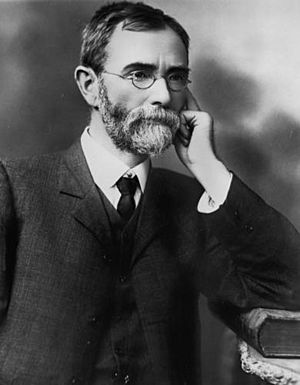Patrick Leahy (Australian politician) facts for kids
Quick facts for kids
Patrick Leahy
|
|
|---|---|
 |
|
| Member of the Queensland Legislative Assembly for Warrego |
|
| In office 11 March 1902 – 18 May 1907 |
|
| Preceded by | David Bowman |
| Succeeded by | George Barber |
| In office 24 September 1907 – 5 February 1908 |
|
| Preceded by | George Barber |
| Succeeded by | Harry Coyne |
| Member of the Queensland Legislative Council | |
| In office 1 July 1912 – 23 March 1922 |
|
| Personal details | |
| Born |
Patrick James Leahy
June 1860 Schull, County Cork, Ireland |
| Died | 13 October 1927 (aged 67) Clayfield, Queensland, Australia |
| Resting place | Toowong Cemetery |
| Nationality | Irish Australian |
| Political party | Ministerialist |
| Other political affiliations |
Opposition |
| Spouse | Julia Alice Costello (m. 1897) |
| Relations | John Leahy |
| Occupation | Journalist |
Patrick James Leahy (June 1860 – 13 October 1927) was an important Australian politician and journalist. He was born in Ireland and later moved to Australia. He served in two different parts of the Queensland government.
Contents
Early Life and Career
Patrick Leahy was born in June 1860 in a place called Schull, in County Cork, Ireland. His parents were Patrick and Mary Leahy. After finishing school in Ireland, he moved to the Colony of Queensland in Australia in 1887. He joined his brother, John Leahy, who was also a politician.
Patrick Leahy started his career as a journalist. He worked for a newspaper called the Brisbane Courier. Later, he moved to Western Queensland and started his own newspaper, The Herald, in a town called Thargomindah. He also became the secretary for the Bulloo Divisional Board, which was a local government group. In 1900, he started another newspaper in Innisfail.
Patrick Leahy's Political Journey
Before becoming a state politician, Patrick Leahy was a member of the Bulloo Shire Council for several years. This was a local government group.
First Time in Parliament
In 1902, Leahy ran for a seat in the Queensland Parliament for the area called Warrego. He was a "Ministerialist" candidate, which meant he supported the government at the time. He won the election, beating the person who held the seat before him, David Bowman. Leahy kept this seat until the 1907 election.
A Disputed Election
In the 1907 election, Leahy lost his seat to George Barber. However, Leahy believed the election result was unfair. He appealed the decision because Barber was an "uncertified insolvent." This meant Barber had financial problems that were not officially sorted out, which could stop him from holding office. In September, a special group called the Elections Tribunal looked into the case. They agreed with Leahy and changed the result, declaring Leahy as the winner instead.
Serving in Government
In November 1907, Patrick Leahy was given an important job in the government. He became the Secretary for Public Works and Mines. This meant he was in charge of things like building roads and managing mining. However, in the 1908 election, he lost his seat again, this time to Harry Coyne.
Joining the Legislative Council
On July 1, 1912, Leahy was asked to join the Queensland Legislative Council. This was a different part of the Queensland Parliament, similar to an upper house. Members of the Legislative Council were appointed, not elected by the public.
Fighting for the Council
Patrick Leahy played a big role in trying to stop the Legislative Council from being removed. He gave many thoughtful speeches against getting rid of it. He strongly believed that the council was important for the government. He was also against any laws that seemed to be too much like "socialist" or "communist" ideas, which meant he didn't like ideas that gave the government too much control over people's lives or businesses. He was also a Justice of the Peace, which meant he had some legal authority, like being able to witness documents.
Family Life
Patrick Leahy married Julia Alice Costello on December 13, 1885, in Thargomindah. They had five children together. Patrick Leahy passed away in October 1927 at the age of 67. He was buried in the Toowong Cemetery in Queensland.

